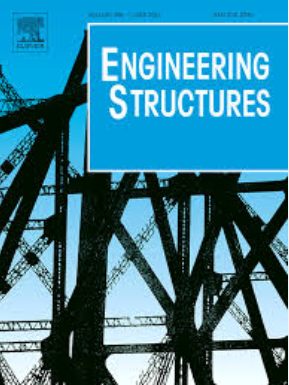Impact performance of fibre reinforced geopolymer concrete beams with steel-FRP composite bars
IF 5.6
1区 工程技术
Q1 ENGINEERING, CIVIL
引用次数: 0
Abstract
Global warming has driven the rapid development of sustainable and durable materials in infrastructure construction in recent years. Demand is increasing as more economies around the world are booming. Geopolymer concrete (GPC), basalt macro fibres (BMFs), and steel-fibre reinforced polymer composite bars (SFCBs) are such materials that enable enhanced structural performance and longevity of structures whilst reducing carbon emissions. SFCB is a kind of new rebar comprising steel rebar as a core and fibre-reinforced polymer (FRP) as an outer layer, i.e., SGCB, SBCB, and SCCB (denoting SFCBs with glass FRP, basalt FRP, and carbon FRP layer, respectively). This study proposes new BMF-reinforced GPC structures reinforced with SFCBs (named BMF-GPC-SFCB structures). Laboratory tests were conducted to investigate the flexural behaviour of BMF-GPC-SFCB beams against impact load with three designed impact velocities (0.23 m/s, 1.56 m/s, and 3.79 m/s), on which the effects of reinforcement type, BMF content, SFCB type, and SFCB ratio were considered in this study. The test results show that the GPC-SBCB beam had smaller residual mid-span deflections than the GPC-Steel beam, and the failure mode changed from flexure in the GPC-Steel beam to flexure-shear in the GPC-SFCB beam due to the higher tensile strength of SBCBs. Increasing the tensile strength and modulus of SFCBs as well as the reinforcement ratio enhanced the impact performance of the GPC beams. This study provides valuable insight into the application of SFCBs for reinforcing GPC beams and test data for the calibration of numerical models.
求助全文
约1分钟内获得全文
求助全文
来源期刊

Engineering Structures
工程技术-工程:土木
CiteScore
10.20
自引率
14.50%
发文量
1385
审稿时长
67 days
期刊介绍:
Engineering Structures provides a forum for a broad blend of scientific and technical papers to reflect the evolving needs of the structural engineering and structural mechanics communities. Particularly welcome are contributions dealing with applications of structural engineering and mechanics principles in all areas of technology. The journal aspires to a broad and integrated coverage of the effects of dynamic loadings and of the modelling techniques whereby the structural response to these loadings may be computed.
The scope of Engineering Structures encompasses, but is not restricted to, the following areas: infrastructure engineering; earthquake engineering; structure-fluid-soil interaction; wind engineering; fire engineering; blast engineering; structural reliability/stability; life assessment/integrity; structural health monitoring; multi-hazard engineering; structural dynamics; optimization; expert systems; experimental modelling; performance-based design; multiscale analysis; value engineering.
Topics of interest include: tall buildings; innovative structures; environmentally responsive structures; bridges; stadiums; commercial and public buildings; transmission towers; television and telecommunication masts; foldable structures; cooling towers; plates and shells; suspension structures; protective structures; smart structures; nuclear reactors; dams; pressure vessels; pipelines; tunnels.
Engineering Structures also publishes review articles, short communications and discussions, book reviews, and a diary on international events related to any aspect of structural engineering.
 求助内容:
求助内容: 应助结果提醒方式:
应助结果提醒方式:


